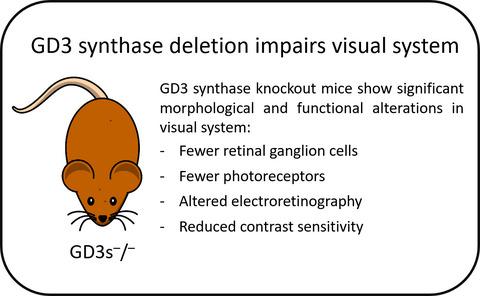当前位置:
X-MOL 学术
›
J. Neurochem.
›
论文详情
Our official English website, www.x-mol.net, welcomes your feedback! (Note: you will need to create a separate account there.)
GD3 synthase deletion alters retinal structure and impairs visual function in mice
Journal of Neurochemistry ( IF 4.7 ) Pub Date : 2021-06-03 , DOI: 10.1111/jnc.15443 Carla Andreia Abreu 1, 2 , Leandro Coelho Teixeira-Pinheiro 1, 2 , Rafael Lani-Louzada 1 , Almir Jordão da Silva-Junior 1, 2 , Juliana F Vasques 1, 2 , Fernanda Gubert 2, 3 , Gabriel Nascimento-Dos-Santos 1 , Ronaldo Mohana-Borges 1 , Eduardo de Souza Matos 1 , Pedro Moreno Pimentel-Coelho 1, 2 , Marcelo Felippe Santiago 1, 2 , Rosalia Mendez-Otero 1, 2
Journal of Neurochemistry ( IF 4.7 ) Pub Date : 2021-06-03 , DOI: 10.1111/jnc.15443 Carla Andreia Abreu 1, 2 , Leandro Coelho Teixeira-Pinheiro 1, 2 , Rafael Lani-Louzada 1 , Almir Jordão da Silva-Junior 1, 2 , Juliana F Vasques 1, 2 , Fernanda Gubert 2, 3 , Gabriel Nascimento-Dos-Santos 1 , Ronaldo Mohana-Borges 1 , Eduardo de Souza Matos 1 , Pedro Moreno Pimentel-Coelho 1, 2 , Marcelo Felippe Santiago 1, 2 , Rosalia Mendez-Otero 1, 2
Affiliation

|
Gangliosides are glycosphingolipids abundantly expressed in the vertebrate nervous system, and are classified into a-, b-, or c-series according to the number of sialic acid residues. The enzyme GD3 synthase converts GM3 (an a-series ganglioside) into GD3, a b-series ganglioside highly expressed in the developing and adult retina. The present study evaluated the visual system of GD3 synthase knockout mice (GD3s–/–), morphologically and functionally. The absence of b- series gangliosides in the retinas of knockout animals was confirmed by mass spectrometry imaging, which also indicated an accumulation of a-series gangliosides, such as GM3. Retinal ganglion cell (RGC) density was significantly reduced in GD3s–/– mice, with a similar reduction in the number of axons in the optic nerve. Knockout animals also showed a 15% reduction in the number of photoreceptor nuclei, but no difference in the bipolar cells. The area occupied by GFAP-positive glial cells was smaller in GD3s–/– retinas, but the number of microglial cells/macrophages did not change. In addition to the morphological alterations, a 30% reduction in light responsiveness was detected through quantification of pS6-expressing RGC, an indicator of neural activity. Furthermore, electroretinography (ERG) indicated a significant reduction in RGC and photoreceptor electrical activity in GD3s–/– mice, as indicated by scotopic ERG and pattern ERG (PERG) amplitudes. Finally, evaluation of the optomotor response demonstrated that GD3s–/– mice have reduced visual acuity and contrast sensitivity. These results suggest that b-series gangliosides play a critical role in regulating the structure and function of the mouse visual system.
中文翻译:

GD3合酶缺失改变小鼠视网膜结构并损害视觉功能
神经节苷脂是在脊椎动物神经系统中大量表达的糖鞘脂,根据唾液酸残基的数量分为a-、b-或c-系列。酶 GD3 合酶将 GM3(一种 a 系列神经节苷脂)转化为 GD3,一种在发育中和成人视网膜中高度表达的 b 系列神经节苷脂。本研究从形态学和功能上评估了 GD3 合酶基因敲除小鼠 (GD3s –/– )的视觉系统。质谱成像证实了敲除动物视网膜中不存在 b 系列神经节苷脂,这也表明 a 系列神经节苷脂如 GM3 的积累。GD3s 中视网膜神经节细胞 (RGC) 密度显着降低–/–小鼠,视神经中的轴突数量也有类似的减少。敲除动物的感光细胞核数量也减少了 15%,但双极细胞没有差异。GD3s –/–视网膜中GFAP阳性神经胶质细胞占据的面积较小,但小胶质细胞/巨噬细胞的数量没有变化。除了形态学改变之外,通过对表达 pS6 的 RGC(神经活动的指标)进行量化,还检测到光反应性降低了 30%。此外,视网膜电图 (ERG) 表明 GD3s –/–小鼠的RGC 和光感受器电活动显着降低,如暗视 ERG 和模式 ERG (PERG) 振幅所示。最后,对视运动反应的评估表明 GD3s–/–小鼠的视力和对比敏感度降低。这些结果表明 b 系列神经节苷脂在调节小鼠视觉系统的结构和功能方面起着关键作用。
更新日期:2021-08-12
中文翻译:

GD3合酶缺失改变小鼠视网膜结构并损害视觉功能
神经节苷脂是在脊椎动物神经系统中大量表达的糖鞘脂,根据唾液酸残基的数量分为a-、b-或c-系列。酶 GD3 合酶将 GM3(一种 a 系列神经节苷脂)转化为 GD3,一种在发育中和成人视网膜中高度表达的 b 系列神经节苷脂。本研究从形态学和功能上评估了 GD3 合酶基因敲除小鼠 (GD3s –/– )的视觉系统。质谱成像证实了敲除动物视网膜中不存在 b 系列神经节苷脂,这也表明 a 系列神经节苷脂如 GM3 的积累。GD3s 中视网膜神经节细胞 (RGC) 密度显着降低–/–小鼠,视神经中的轴突数量也有类似的减少。敲除动物的感光细胞核数量也减少了 15%,但双极细胞没有差异。GD3s –/–视网膜中GFAP阳性神经胶质细胞占据的面积较小,但小胶质细胞/巨噬细胞的数量没有变化。除了形态学改变之外,通过对表达 pS6 的 RGC(神经活动的指标)进行量化,还检测到光反应性降低了 30%。此外,视网膜电图 (ERG) 表明 GD3s –/–小鼠的RGC 和光感受器电活动显着降低,如暗视 ERG 和模式 ERG (PERG) 振幅所示。最后,对视运动反应的评估表明 GD3s–/–小鼠的视力和对比敏感度降低。这些结果表明 b 系列神经节苷脂在调节小鼠视觉系统的结构和功能方面起着关键作用。



























 京公网安备 11010802027423号
京公网安备 11010802027423号